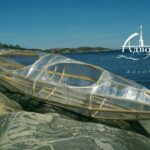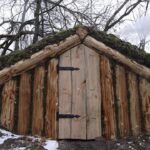How to Snare Wild Pigs
Josh Helcel: Wild pigs are an invasive species that threatenagricultural production, water quality, nativespecies, and habitat. In Texas, legal methodsfor controlling expanding wild pig populationsinclude the use of snares, and these relativelysimple devices can be used effectively incertain situations to capture wild pigs. Tracksin a trail or path, muddy rub marks on trees,hair caught in a fence where wild pigs crawlunder, and wallows near watering holes areexamples of locations for setting snares. A snare consists of a wire loop with a lockingdevice that tightens around the animal’sbody as it passes through the loop, and thereare two general uses for snares: foot snaresand neck snares. Common methods for settingneck snares for wild pigs include trail sets,fence sets, and drag sets. Adam Henry: Today we’re out here on a ranch that’sgot some hog problems, and we’re settinga trail snare, or a variant of a trail snare. We had a nice trail right here in front ofus; it’s coming through the cedar trees– and looked like a good place to hang atrail snare. We started out with putting ina support rod, so that we could have a placeto hang our snare. You got to have a goodfoundation to hang a snare, and so we drovea rod in, added some support wire, clippedit onto our snare right behind the lock sothat the lock could move freely and closeon the animal. The next thing we did is weadded some blocking material. We added a pieceof cedar, blocked down our trail, hada nice narrow spot right here – we addeda nice cedar stake and then some more blockingright here as well to funnel that animal intothis hole as they’re walking down the trailand not give them an option to take a differentpath. We’ve tied off our extension, right overhere to one of these trees so that when theanimal is caught, he can pull on out and wrapup underneath the tree and he doesn’t stayright on this trail. Other animals can comeup and down this trail as needed, and we cancontinue to rebuild this location and catchas many hogs that want to come down . Obviously we are using a standard 1/8th inchsnare cable with a washer lock that does verygood for us and a very easy piece ofequipment to set. We’re going to set itabout like that, and hope the animal comesin, gets his head in here and gets caught. Josh Helcel: The potential to capture non-target speciesis one of the downsides of snaring, but unintendedcaptures can be minimized by a small amountof prior research and knowledge of animalbehaviors. To reduce the chances of capturingnon-target species, a trail camera shouldbe used to monitor proposed snaring sitesprior to snaring. If you notice a high amountof non-target species using the area it isrecommended to find another location. It isalso recommended that you purchase a huntinglicense, which is required for snaring furbearing animals. Adam Henry: got a nice slide coming underneaththe fence, and we’re going to hang a snare. We’ve already attached our swivel to thebottom wire, and we’ve wrapped a doublelayer of 14 gauge tie wire around it and tightenedit down. We’re going to go ahead and hangour snare using our snare clips, which arethese little clips right here we’ve made,and we’re going to put oneright here by the swivel to support it. We’regoing to come out here behind the lock andput another one, and pinch the ends down tight,and then right out here about half way out,in front of the lock, we’re going to putthe other clip and pinch it down. Now this clip out here allows the snare tohave tension on it – it keeps it up, letsthe animal come though and really get thatsnare down around their neck before it pullsoff and comes down with the animal. Once hepulls that snare , he’s got a lot of forcein it right here so that helps close the snareand get a good secure catch on the animal,and then he’ll be caught right here whenyou get back. Josh Helcel: Snares are inexpensive, and can be purchasedfor between $2 and $4 dollars each. They requireminimum equipment for installation, and needlittle maintenance. Snares are designed tocapture one wild pig at a time, but are aone-time use item, and should be discardedafter capturing a wild pig. Unused snaresshould be removed from the locations wherethey are no longer needed. Adam Henry: In front of me is a log, we’re going touse it for a drag, and we have two ways tohook it to our tab end here, and we can usea little bit longer extension – and basicallywe’re just going to run that extension arounditself and get a slip knot on our log, andthen, we’re going to take our snare andput it through the loop end on there on ourextension and pull each other tight. Once we’ve got it on the log we can alsotake a piece of tie wire and run it aroundthe log, and come through the open loop endof our extension – and just give it a coupletwists so that in the event they get to pullingreal hard this end doesn’t open up and tearloose. It stays right in place. It’s notgoing to hurt anything like that. You cancut the excess off if you want, you don’thave to. In the middleallows the drag to pull perpendicular to thedirection of travel of the animal and hangup better in the brush. If we put it on oneend its liable to lay out straight parallelwith the direction of travel and it may nothang up in the brush as the animal is running. If we’re going to use a, again, if we’regoing to use a drag we need to make sure thatwe’ve got at least 6 foot of cable, becausewe want that drag to be flopping in the brushas the animal is running – we don’t wantit to track right along their body. If weused just this short tab end of the snare,hooked on here, this drag may not actuallyhook up on anything. Josh Helcel: It is important to understand the laws concerningthe use of snares, and to keep a keep a detailedrecord of snare locations so they can allbe checked daily. If the goal is to removean entire sounder of wild pigs, snares maybest be used when combined with other controltechniques including trapping, shooting, aerialgunning, and the use of trained dogs. This has been an overview of the snaring process,including demonstrations of three common typesof neck snares for wild pigs. You can findmore information about wild pigs, their impacts,and how to effectively reduce populationsat http://feralhogs. tamu. edu



